A Town With An Ocean View (Umi No Mieru Machi)
- andreahywong

- Jul 19, 2020
- 9 min read
Updated: Jul 30, 2021

It's been so long since I've transcribed something, so here's another habit-building attempt! I really fell in love with this YouTube Video of various Studio #Ghibli film scores composed by the amazing #Joe#Hisaishi. Fun fact, did you know his composing pseudonym is inspired by #Quincy#Jones? It's so neat to find how artists of different genres inspire each other.
Anyway, I've picked a soundtrack, A Town With An Ocean View, from #Kiki's Delivery Service that's been a childhood favourite, and sounded relatively manageable to transcribe. I really enjoyed this video's Piano/Violin arrangements by YUKA, and might come back to transcribe other favourites. The textural variety, the lightness, I felt like the arrangement really captured the sense of childlike wonder and imagination in these pieces, and was definitely successful in giving me that sense of nostalgia from when I first watched these films - isn't it fascinating music can do that?

Original Duration: 2:05 minutes (125 seconds)
Time Taken To Transcribe (T.T.T.T. in minutes): 23 (violin/melody) + piano [30 (A-B) + 40 (C, revisit harmonies) + 32 (D) + 0 (E) + 32 (F) + 45 (G) + 26 (H) + 15 (I) + 90 (articulation/ details/ cleanup] = #TTTT 333 minutes (better known as 5 hours 33 minutes)! I can only hope it gets better with practice!
July 13:
Violin
23 minutes (all violin/melody): I transcribed the easier violin part first (with some distractions whoops). It was pretty clear there were separate sections alternating between the violin pizz and arco, and the melody got passed around, so some of it was an easy copy-and-paste.
It appears the general structure of themes in this piece is Intro/A-pizz/A-arco/B/A-pizz/C/B/D/A-arco. Post edit: Pretty sure you don't label rehearsal markings this way, I'm going to change it to... ABCDEFGHI. I know. I over-complicated it.
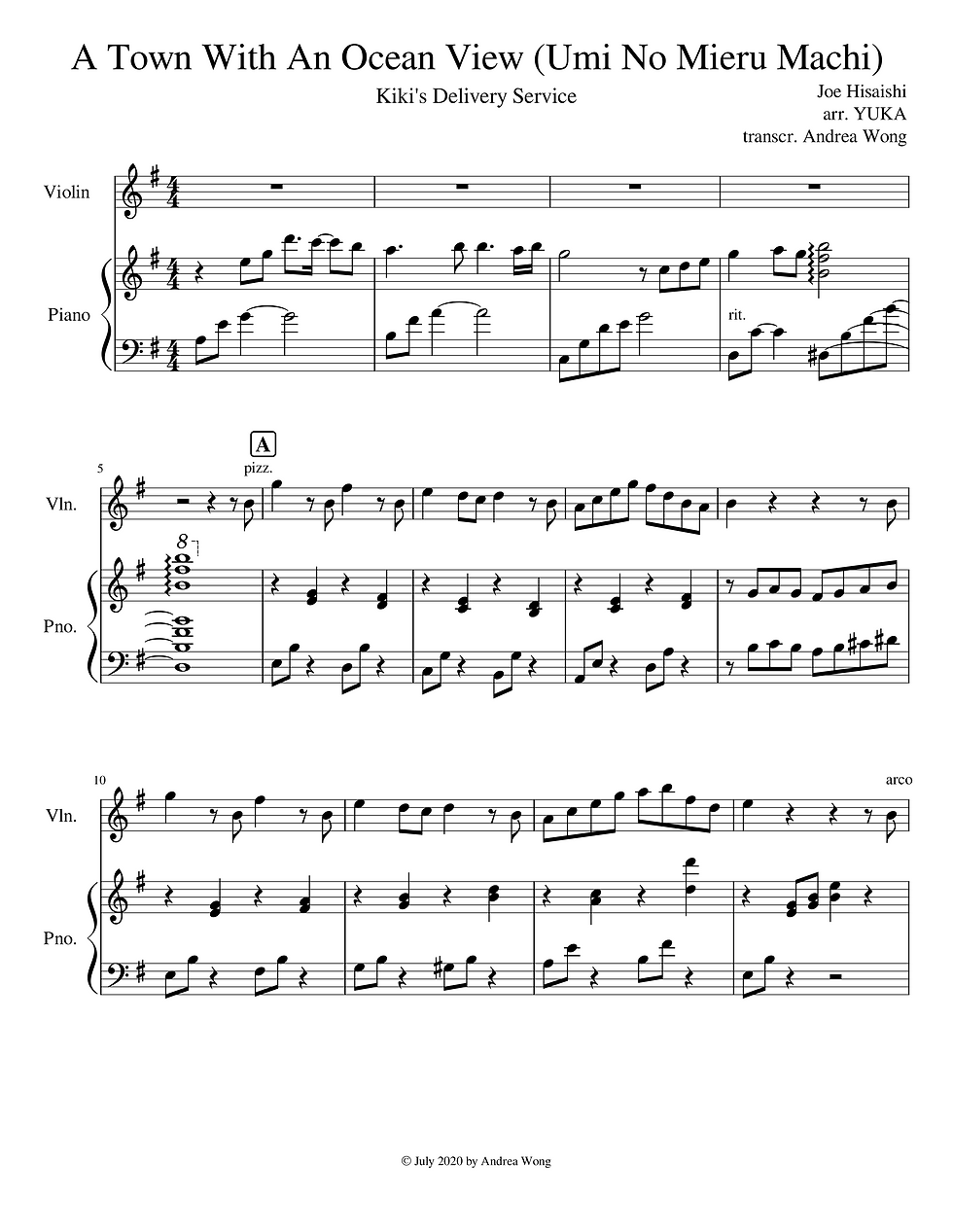
Piano
~30 minutes (up to measure 15):
I forgot when I started this section but I'll approximate and overestimate to 30 minutes. Immediately, the inner harmonies in the piano accompaniment were noticeably harder for me to pinpoint. I definitely needed a nearby keyboard to figure out the harmonic pitches. I also had this video which, although isn't my favourite performance of the rendition, seems to have a clearer piano for transcribing. There might be some differences so I'll have to see which minor details I want to keep in the end - likely consistent with the original video I've linked here. SO. So far I have:
July 15:
Piano cont...
~30 minutes (add up to measure 20, revisit harmonies up to measure 15):
Not too much progress here, but I realized something worth spending time on...

I noticed here there were a few things going on that contributed my to my struggle. I was definitely too focused on a "note" rather than its role in the piece as a whole - the harmonies. The themes are repeated various times, and the simplicity of this (sometimes exact) repetition in the melody is really beautiful with varied subtle harmonies. I think learning to recognize chords as a whole rather than specific pitches might help.
It's definitely not rocket-music-theory, but I thought the different harmonies and contrary motion of the piano's lower frequencies between the antecedent and the consequent of the period of "section A melody" was very tasteful.
A short aside on Periods ...
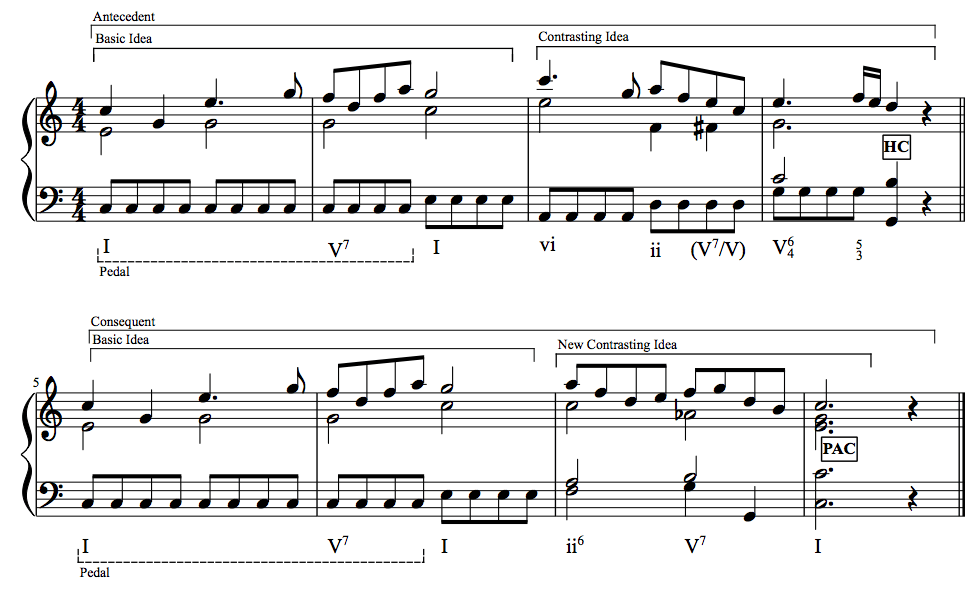
It's been a while since I've done any music theory, so here is a figure I appreciated from this site (The Art of Composing, which is written by a Film Composer, Jon Brantingham - I found it through an image search but should really come back to this! #future #resources #composition) that labels a Period's antecedent and consequent pretty clearly (I'm not proud of it, but I still mix up Sentences and Periods...).
Back to business...
I ended up spending some time on formatting with stems in measure 13.
leftmost: This was the default look I had on the score. I wanted to minimize the ledger lines in the LH but keep the upward motion of both hands.
second from left: Adding a voice in the top staff made it look like the RH played both notes which wasn't preferable. The rests in the LH added to this misconception too.
centre: This looked a bit better with opposite stems, but the LH rests still persisted
second from right: Dealing with the cross-staff beaming was definitely the way to remove the LH rests but... Oh horror! The staccatos were a nightmare, and I think it's just another limitation found in musescore. Manually it is!
rightmost: The stems in the first 2 LH notes still seem funny to me (somehow I wish they were all stems down) but this is the best I could do for now.
July 18:
Piano cont...
I reorganized my #rehearsal #markings so it's now A-I. I wasn't sure if measure 1 should be section A or not, but some comments online seemed to mention it would be odd for the possibility to start "before" the first rehearsal marker. For simplicity and clarity, section A on measure 1 seems to be fine.


10 minutes (finish piano up to and including m. 21):
You'll see above that I also learned how to set a note to a different #colour! Thought this would be a good tool to jot down which notes I'm not super confident about. Then I don't have to re-visit and figure it out each time if I've made "note" of it as I go. #punintended
22 minutes (section D):
I thought m. 28-29 were a bit tricky for some reason, and the pink bass notes in m. 22-23 actually took me an extra 10 minutes to be #confident about. When I slowed it down, it was actually harder to hear the pitch, and easier at normal speed which I found interesting. I'll have to revisit this and look more into it. #future
July 19:
Piano cont...
0 minutes (section E):
So I'm fairly sure section E is actually just a repetition of B. This was a an easy copy-paste. Initially, I wasn't sure if I should've done some "repeats-gymnastics" with signs and D.C./D.S.es and codas. But despite using more space/paper/ink, copy-pasting seems to be the most clear and straightforward. I find even though there are less pages, sometimes the page turns are a nuisance depending where they happen too.
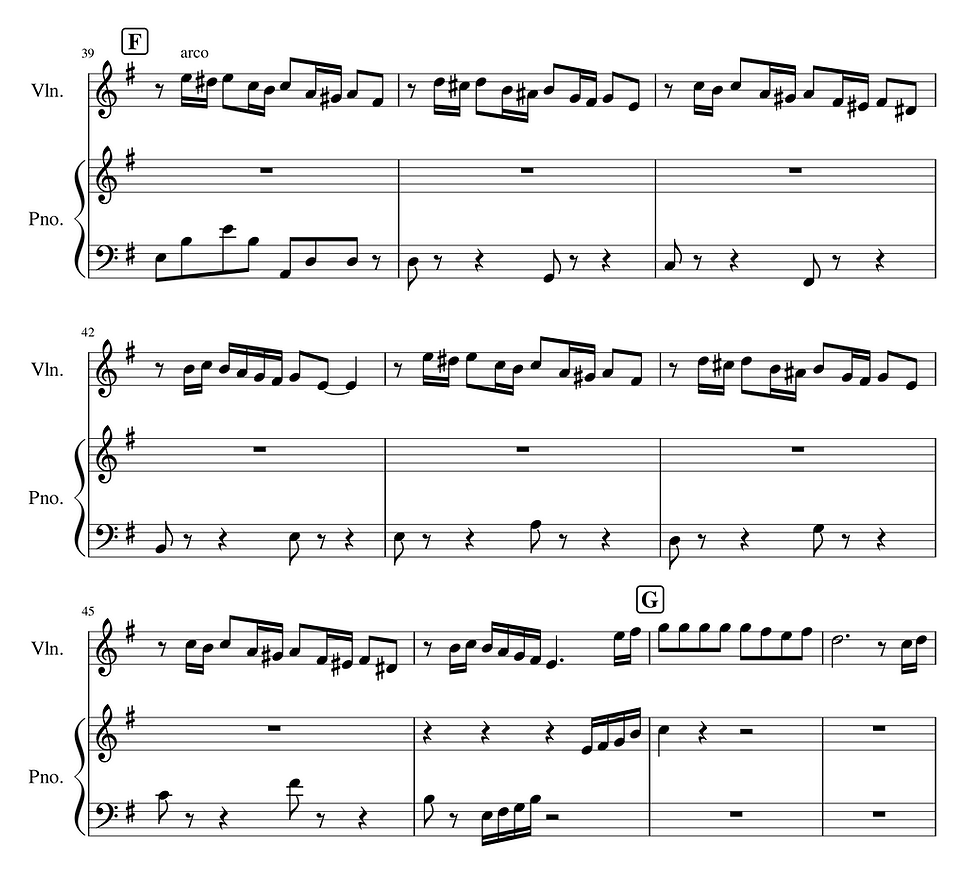
32 minutes (section F):
Focusing on the piano part, section F's repeat is actually very clearly not a repeat. The violin plays the same notes, but the piano is varied. So I'll have to remove the repeat and add a few more measures to F.
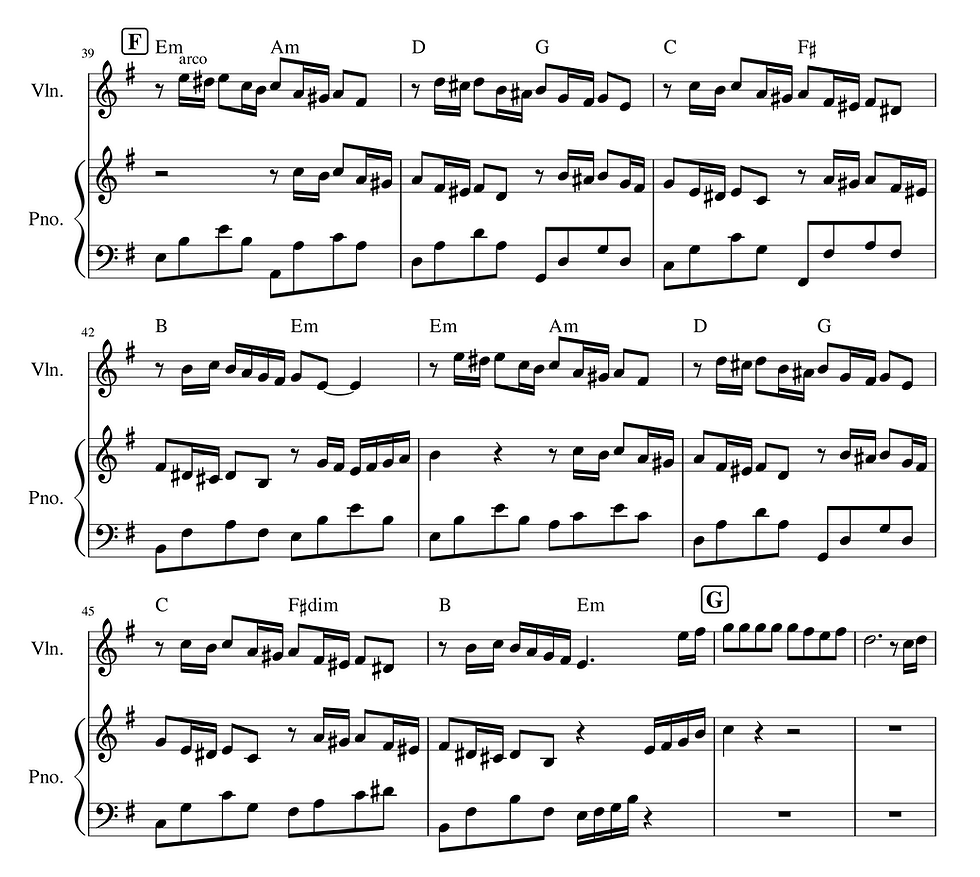
Once again, I was finding some difficulty honing in on the specific notes, and decided to find the bass notes every 2 beats. This way, I had a good sense of the harmonic foundation. But wowowow, does my registral pitch struggle. My first notes are frequently in the wrong octave in the lower end/piano LH, which is definitely a weakness in my ear.
A not-so-short aside on The Fletcher-Munson Curve ...
My struggle with the lower pitches reminded me of some #equal-#loudness #curves I had learned briefly about in school. The simple version of what these curves mean, is that humans #perceive the loudness (subjective) of frequencies (objective) differently. A frequency can be objectively more intense (dB), but perceived subjectively to be the same, or even "softer/less loud". The red lines seen below are the different "levels" of loudness, called #phons. Everything on the same line is perceived as more or less the same loudness. You can see the bottom line is the subjectively perceived threshold of audibility, and the top line is the threshold of pain - and not an objective ultimate silence and infinite dB.
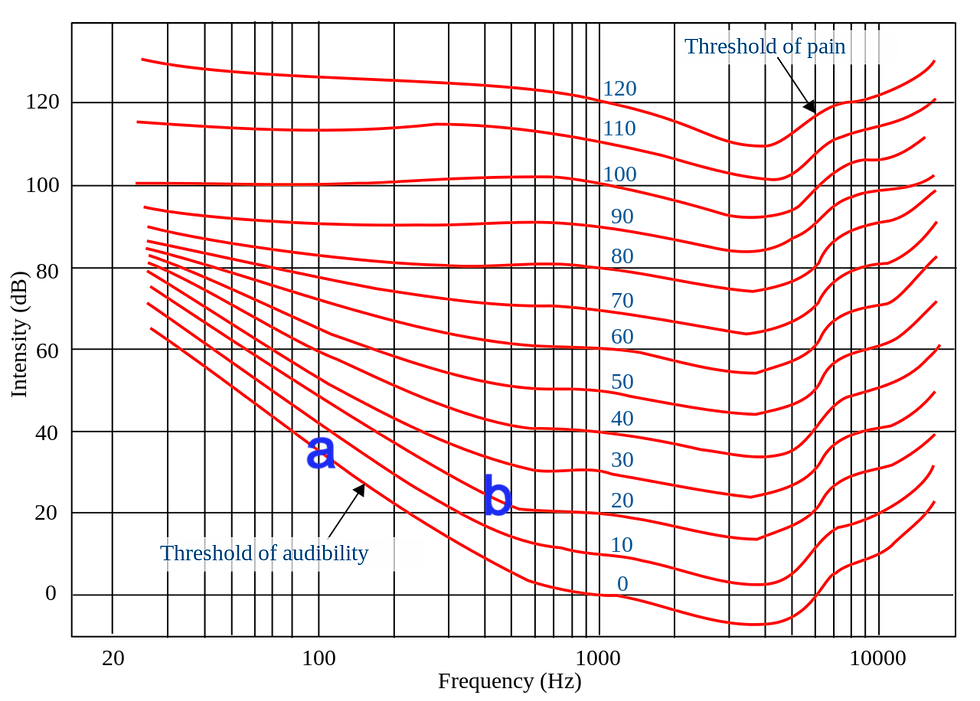
Take point a in this diagram:
frequency ~100 Hz intensity ~35 dB
phon 0
And point b in this diagram:
frequency ~450 Hz intensity ~25 dB
phon 20
Point a is objectively more intense (35 dB > 25 dB) than point b, but perceived as less loud (i.e. on a lower level of loudness: 0 < 20 phons)!
Ok Andrea, where are you going with this?
Well, maybe this has something to do with my difficulty hearing the pitches in the piano's LH (or I'm just making excuses now... ).
The piano's A2 frequency is 110 Hz - similar to point a (seen on beat 3 of measure 39 in section F above).
A violin's open A string is an A4; its frequency is 440 Hz - similar to point b (seen on beat 3 of measure 41 in section F above).
The violin's range is about G3-A7, frequencies of 196 - 1760 Hz. This is definitely in the "dip" seen in the red curves where the human ear is most sensitive to (also where most of human speech frequencies lie! Coincidence? I think not...).
The lower end of the piano (let's say below middle C, or) C4, has a frequency of 262 Hz, much to the left of the "dip", in the left third of the diagram.

An aside from our aside... Fun fact: I actually recently went for a hearing test about a month ago...
... and it appears the general evaluation tests for your ability to hear sounds in the 250 - 8000 Hz frequency range. Cool! (Happy to say my hearing is within normal limits. Maybe I'll blog about that #experience in a #future post).
So. It's possible that the combo of piano and violin, with their different frequencies and subjectively perceived loudness, that I'm not completely crazy in struggling to hear those lower notes. However, I doubt that both instruments were playing at the same intensity/dB to be properly controlled for me to say that. But also! (I promise, this is the last detour before I get back to transcribing...) this makes complete sense that the violin is mostly on the melody (what we want to focus on more). The piano also seldom plays in its higher octaves in this piece. They definitely have their own #registral #zones that provide clarity of each part through their pitch differences. Not that the piano can't have melody lines in an ensemble (just look at all the piano concertos out there!), or even in this piece (see section H). Anyway, I digress...
... back to it!
~45 minutes (section G):
The LH rhythm in m. 51-52 definitely took me some time. I initially thought they were straight half notes, but it didn't make sense with the upward arpeggiating pattern from before. Why would it stop? It sure doesn't sound like that upward motion has stopped. The held notes in m. 54 were tough for me to hear too. I'm not sure if it's the recording's reverb, the piano's sustain/damper (rightmost) pedal, or if those notes are actually present. Here's what I have so far:


26 minutes (section H):
Since I already transcribed the melody from July 13, I just had the LH to transcribe. I started with beats 1 and 3, and then 2 and 4. This process seemed to ground me better and not worry about missing notes in-between, giving me more time between beats to... prep myself to listen? I'm not sure why this worked better for me to be completely honest.
Some #doublings were hard to hear, and I'm still not sure if they're actually present or once again, if it's just the pedal/early room-reflections in the recording. I decided to leave them out at m. 63 (I thought there might be an octave doubled here). I noticed there were inner RH notes on beats 1 and 3 which were also hard to hear because of the pianists gorgeous RH voicing.


15 minutes (section I):
Section I was very similar to section C (there were some minor differences in the piano RH like in m. 66) but generally a quick task up until the ending at m.71. For the formatting: I decided to use #Musescore's #visibility function. you'll see below the rests in the lower piano staff are gray - these are #invisible features and wouldn't be seen when exported and/or printed. I definitely wanted to avoid the beaming #nonsense I attempted in m. 13 and honestly, this seems to work just fine with appropriate stem directions to suggest the LH playing the lower notes in the top staff.
~70 minutes (articulation):
I thought I'd add some details like slurs/bowings in the violin part, and some in the piano part (slurs/phrasing, tenuto markings, pedal...). I know I wanted to suggest a hand crossing in m. 53 too. I learned that I prefer notating piano pedaling with the brackets |_____/\_____| rather than the more traditional Ped * markings. The brackets seem clearer to me regarding when to take the foot off/on the pedal.
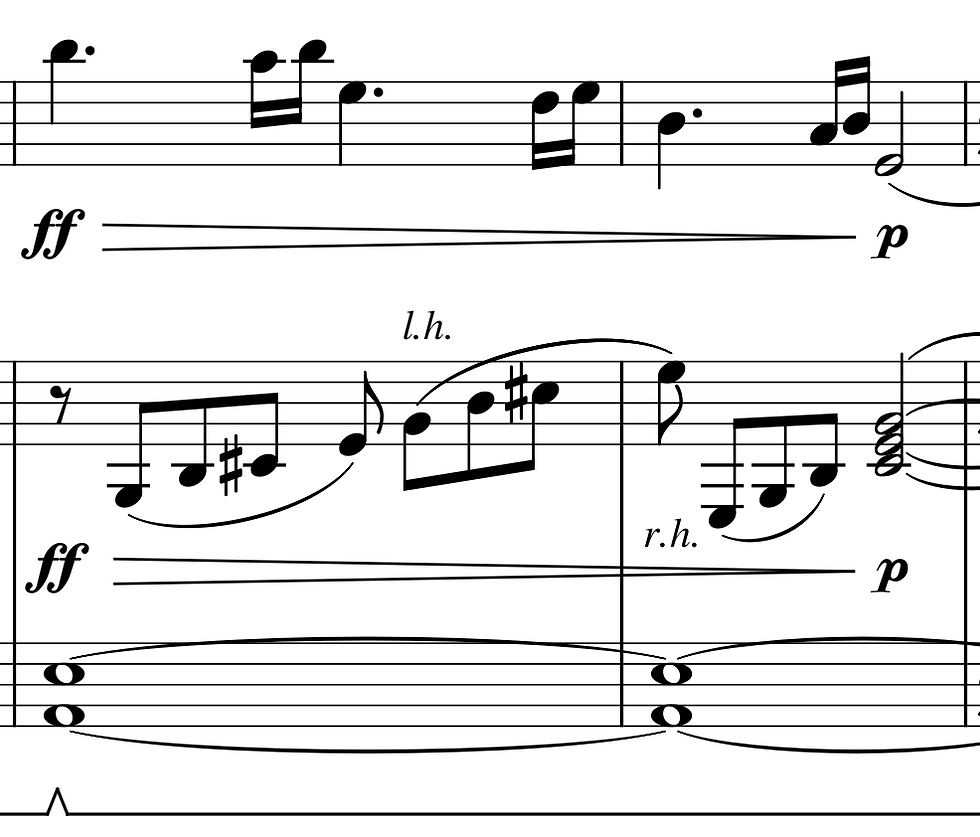
The hand crossing wasn't too complicated. Just some stem and slur adjustments. Adding l.h. and r.h. text were no issue. I know some scores have a large "scooped" notation to separate the left and right hand notes. I wasn't able to find that feature in Musescore... unless they're just large edited slurs?
Below is a score of Liszt's Un Sospiro for piano. It seems to indicate hand crossings with just m.s. and m.d. indicators (And yes. 2 staves weren't enough for Liszt. He needed three. What a champ.)

It also turns out that I have no idea how to #articulate pizzicato sections for violin. Does it make sense to add accents? Staccatos? Slurs? I honestly need to look into it. There's a comical lack of articulation in those sections.
Also: violin slur.. endings? Should I end the slur with a staccato or not? I decided in the end to add the staccato for an "off-the-string" sound because the end of the phrase/slur-marking doesn't indicate that a note's duration is shortened. I think...
~ 20 minutes (dynamics/cleanup):
Nothing too fancy here. It took a bit of time to add some sectional dynamics and crescendo/decrescendo transitions. I didn't want to over-notate with too much notation regarding the dynamic contour of phrases. I then edited some margin and system/staff spacing, and removed the chord symbols to clean it up.
AND FINALLY......
I think the end result it looks alright! It's 6 pages, so I've just attached the pdf below instead of pasting one large rolling screenshot. Here it is!
With the pandemic keeping everyone home and working from home, this was actually a piece chosen for a work casual-online-social-(distancing) event (which I took as a great opportunity to transcribe although, it took much longer to transcribe than to learn just my part). A co-worker of mine who plays the piano is going to learn this with me for a lunchtime "Music Monday". I'll have to come back and upload either a recording of that or a Soundcloud audio clip of the MIDI parts so you can hear the end result!
Onto the next!













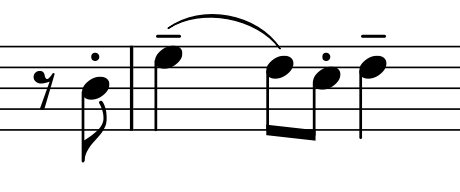

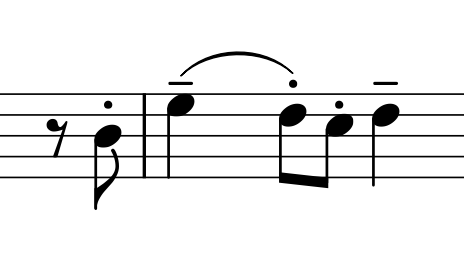



Comments